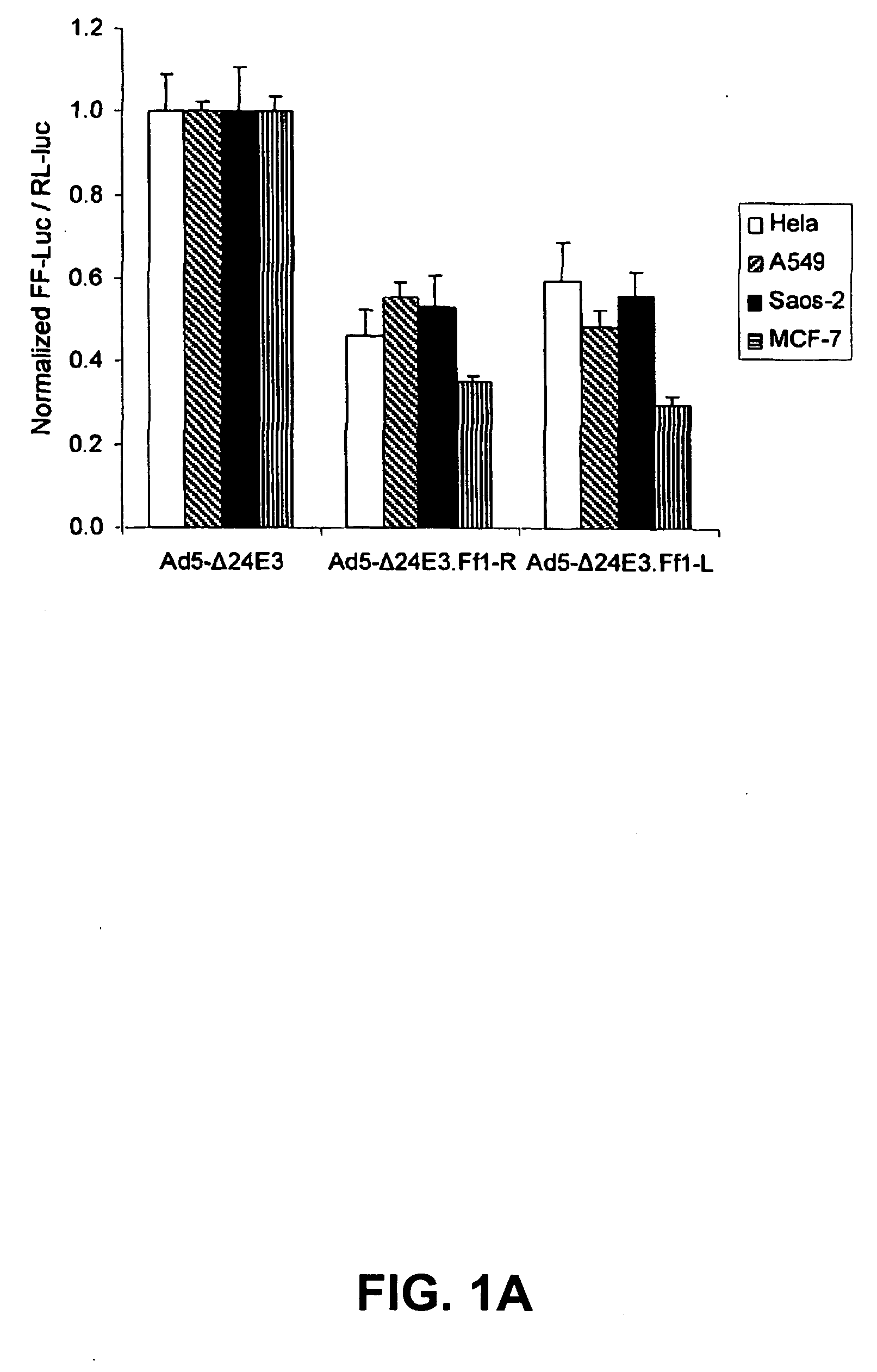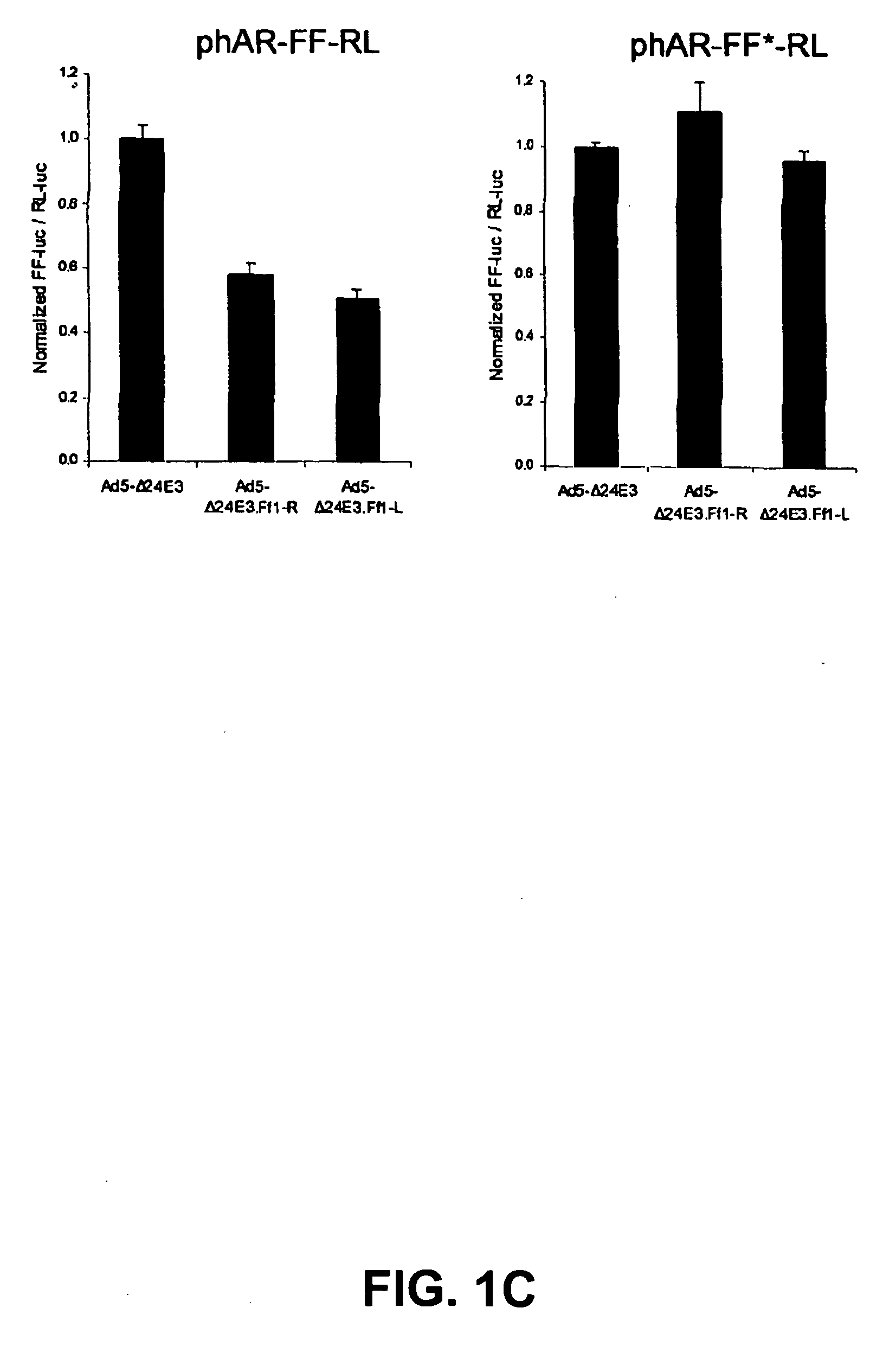Replication competent viruses capable of silencing virus inhibitory factor expression
a technology of silencing virus inhibitory factor and replication competent viruses, which is applied in the field of gene modification, biotechnology and medicine, can solve the problems of limiting the duration of in vivo replication of replication-competent adenoviruses, and achieve the effects of rapid adenovirus life cycle, rapid life cycle and rapid production process
- Summary
- Abstract
- Description
- Claims
- Application Information
AI Technical Summary
Benefits of technology
Problems solved by technology
Method used
Image
Examples
example 1
[0119] Construction of adenovirus shuttle vectors carrying a Gateway recombination destination cassette.
[0120] To construct a shuttle vector carrying a Gateway recombination destination cassette between the adenovirus E4 region and the right-hand ITR, the construct pEndK / SpeI (generously provided by Dr. R. Alemany, Institut Catalan d'Oncologia, Barcelona, Spain) was used. pEndK / SpeI was made by first digesting pTG3602 (Chartier et al., J. Virol. 70(1996):4805-4810) with KpnI and religating the vector fragment comprising Ad5 map units 0 to 7 and 93 to 100 to create pEndK. Next, a unique SpeI site was introduced into pEndK by changing Ad5 nucleotide 35813 from A to T by site-directed mutagenesis to create pEndK / SpeI. PEndK / SpeI carries PacI restriction sites flanking the two Ad5 ITRs. pEndK / SpeI was made compatible with the Gateway system by ligating the Gateway destination cassette rfa (Gateway Vector Conversion System; Invitrogen, Carlsbad, Calif.) as a blunt fragment into the SpeI...
example 2
[0123] General method to construct plasmids with an shRNA expression cassette that can be transported into an adenovirus shuttle vector according to Example 1 by Gateway recombination.
[0124] The plasmid pSHAG-1 (Paddison et al., Genes Dev. 16(2002)948-958; generously provided by Dr. G. J. Hannon, Cold Spring Harbor Laboratory, New York) is used as entry clone for the GATEWAY system (Invitrogen, Carlsbad, Calif.). pSHAG-1 contains a U6 promoter-driven expression cassette flanked by the attL1 and attL2 recombination sites such that the expression cassette can be transported into destination plasmid vectors including pEndK / DEST-R, pEndK / DEST-L, pBHG11-DEST_R and pAdΔ24-DEST_R of Example 1 using the Gateway system. shRNA-encoding sequences can be introduced by ligation of pSHAG-1 digested with BseRI and BamHI with two annealed synthetic oligonucleotides with compatible overhanging DNA sequences. The first of the two oligonucleotides should be designed to contain in the 5′ to 3′ order: ...
example 3
[0125] General methods to construct adenovirus shuttle vectors carrying an shRNA expression cassette using the plasmids from Examples 1 and 2.
[0126] To construct an adenoviral shuttle vector carrying an shRNA-expression cassette inserted between the E4 region and the right-hand ITR, the shRNA expression cassette is transferred from the pSHAG-shRNA construct of Example 2 to the pEndK / DEST-R or pEndK / DEST-L plasmid of Example 1 via an in vitro GATEWAY LR recombination reaction using the GATEWAY LR Clonase enzyme mix (Invitrogen) according to the manufacturer's protocol. This results in pEndK / shRNA-R or pEndK / shRNA-L. For example, pSHAG-Ffl is recombined with pEndK / DEST-R or pEndK / DEST-L creating pEndK-Ffl-R or pEndK-Ffl-L, respectively.
[0127] To construct an adenoviral shuttle vector carrying an shRNA-expression cassette inserted in place of the E3 region, the shRNA expression cassette is transferred from the pSHAG-shRNA construct of Example 2 to the pBHG11-DEST_R plasmid of Example...
PUM
| Property | Measurement | Unit |
|---|---|---|
| temperature | aaaaa | aaaaa |
| temperature | aaaaa | aaaaa |
| temperature | aaaaa | aaaaa |
Abstract
Description
Claims
Application Information
 Login to View More
Login to View More - R&D
- Intellectual Property
- Life Sciences
- Materials
- Tech Scout
- Unparalleled Data Quality
- Higher Quality Content
- 60% Fewer Hallucinations
Browse by: Latest US Patents, China's latest patents, Technical Efficacy Thesaurus, Application Domain, Technology Topic, Popular Technical Reports.
© 2025 PatSnap. All rights reserved.Legal|Privacy policy|Modern Slavery Act Transparency Statement|Sitemap|About US| Contact US: help@patsnap.com



